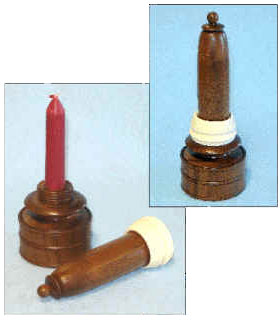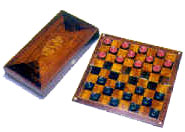
Ask Tim Inman for a description of his job, and the word eclectic is certain to come to mind. For starters, Inman operates a full-service furniture restoration company along with his wife, Joyce. By rights, that should fill his time, but as it turns out, it only accounts for part of it.
“Probably half of my day is woodworking, restoring and finishing,” Tim says, “and the rest is spent formulating specialty chemicals and compounds for the restoration industry, which are sold both directly and through Kwick Klean.” What he fails to mention is that he also publishes both new material, and republishes out-of-print works. I guess that task is relegated to the third half of his day.
His restoration business deals with antique furniture, gilded picture frames, clock repairs, mirror resilvering: in short, almost anything that customers throw his way. Oddly enough, he takes the most pride in work that is not seen.
“My special skill with woodworking is to be like a thief in the night,” Tim explains. “I go into a piece of furniture, recreate the original craftsman’s technique, repair and replace parts, and leave it looking as if I never touched it. When I do my best work, no one can tell I have done anything.

“Because I am restoring things that come from different time periods, I sometimes use hand tools and sometimes machine tools. In order to reproduce, I need to use the original tools and techniques as well as the original wood. Part of the restoration includes turning and cutting odd materials, like bone, horn, hooves and imitation versions of ivory and tortoiseshell.” The real versions of the last two are endangered, and no longer legally available.
The chemical end of Tim’s work follows in the same vein: he makes specialty materials to help others who do the same work. They include chemicals to remove and replace silvering on mirrors, molding compounds for casting missing parts on furniture, coloring sets for polyester fillers such as Bondo®, and even materials for restoring antique picture frames that lock down loose gesso, the plaster coating commonly used under gold leaf.
Then there are the books and CDs, both books he has written and reproductions of old out-of-print finishing manuals. His own writings are primarily technical manuals for restorers, covering topics like casting and molding, silvering, veneering and other similar tasks. A few of these monographs are currently available, and more will be once he regains the copyrights to some of his other writings that are tied up in another company’s bankruptcy.
Recently, he reissued a book that was originally published in 1916 in Grand Rapids, Michigan, then the hotbed of furniture manufacturing. The book was called Problems of the Finishing Room and is surprisingly comprehensive. “It is the most definitive finishing book I have ever seen,” insists Tim. “It has formulas and procedures and runs about 440 pages. I had intended to reprint it on paper, but it was too expensive.” Instead, he produced it as a CD. It’s currently available on Amazon.com, as well as through Tim’s web site.
The fact that it seems like he spends a lot of effort helping his competitors becomes more understandable when you look back over his history. Much of his time was spent teaching others, and that inclination still runs strong in him.
“I started woodworking when I was 12 years old,” Inman recounted. “My dad, who is a cabinetmaker and carver, brought home a wood lathe and some old wooden bowling pins, and I turned them into shavings. After high school, I decided I wanted to be an industrial arts teacher, so I got a teaching degree in college, then went to law school. I dropped out of law school once I realized that while I may have had the head for law, I certainly did not have the stomach for it.
“I taught in public schools for about four years, but I hated the required lunchroom duty. For a while, I ran a paint and hardware store, owned a publishing company called Red Rose Press, opened a refinishing business, and then came the great Minuteman debacle.
“I was teaching classes for Minuteman, a furniture stripper supply company, and had developed a silvering process that they marketed. They tried to hire me in 1980. Instead, I became part owner of the company, and for the next two decades, we grew Minuteman into a full-line restoration company, including finishing, veneering, casting and all types of restoration products. While Minuteman did not do the work, they did the training and sold supplies to help other people start their own refinishing businesses. I was part teacher, part product developer, and part legal and business advisor. It was a fun time.

“The company was sold in 2000, but I remained on as a consultant to the new owners for about two years.” Once his contract was up, he eased into semi-retirement, a term that apparently means working full-time in his own company. “In the meantime,” he continued, “the new owners bankrupted Minuteman, leaving many of our former customers lacking specialty items they had come to rely on.” Always soft of heart, Tim started producing some of those materials to help out his fellow restorers.
“After Minuteman fell off the cliff,” recounts Tim, “I was officially retired. During the Minuteman years, I had taught over 500 seminars to over 10,000 students, and they were, on the whole, the happiest, most satisfied, creative, interested, outgoing and interesting people I’ve met. I love being in people’s workshops. Woodworkers are open, enthusiastic, and always have a story. They’ll talk to you about their most recent discovery, and eagerly share it with you.”
Tim is clearly no different. “Life is what you make it,” Inman says, “and I try to make it fun every day. I was not happy as a law student, so I made the determination that I was going to be happy, and I have worked at that ever since.” To hear him tell it, he’s certainly been successful at that.
“This has been a fascinating career. I was paid for my first refinishing job when I was 14 years old, and still enjoy the trade today every bit as much as I did 42 years ago. I’m the luckiest guy in the world.”





